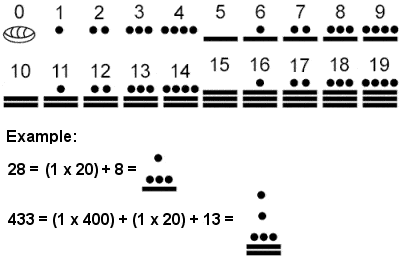MAYAN MATHEMATICS
 |
| Mayan numerals |
The Mayan civilisation had settled in the region of Central America from about 2000 BCE, although the so-called Classic Period stretches from about 250 CE to 900 CE. At its peak, it was one of the most densely populated and culturally dynamic societies in the world.
The importance of astronomy and calendar calculations in Mayan society required mathematics, and the Maya constructed quite early a very sophisticated number system, possibly more advanced than any other in the world at the time (although the dating of developments is quite difficult).
Vigesimal – Base 20 Number System
The Mayan and other Mesoamerican cultures used a vigesimal number system based on base 20, (and, to some extent, base 5), probably originally developed from counting on fingers and toes. The numerals consisted of only three symbols: zero, represented as a shell shape; one, a dot; and five, a bar. Thus, addition and subtraction was a relatively simple matter of adding up dots and bars. After the number 19, larger numbers were written in a kind of vertical place value format using powers of 20: 1, 20, 400, 8000, 160000, etc (see image above), although in their calendar calculations they gave the third position a value of 360 instead of 400 (higher positions revert to multiples of 20).
Mayan zero
The pre-classic Maya and their neighbours had independently developed the concept of zero (Mayan zero) by at least as early as 36 BCE, and we have evidence of their working with sums up to the hundreds of millions, and with dates so large it took several lines just to represent them. Despite not possessing the concept of a fraction, they produced extremely accurate astronomical observations using no instruments other than sticks and were able to measure the length of the solar year to a far higher degree of accuracy than that used in Europe (their calculations produced 365.242 days, compared to the modern value of 365.242198), as well as the length of the lunar month (their estimate was 29.5308 days, compared to the modern value of 29.53059).
However, due to the geographical disconnect, Mayan and Mesoamerican mathematics had absolutely no influence on Old World (European and Asian) numbering systems and mathematics.
| << Back to Roman Mathematics | Forward to Chinese Mathematics >> |
